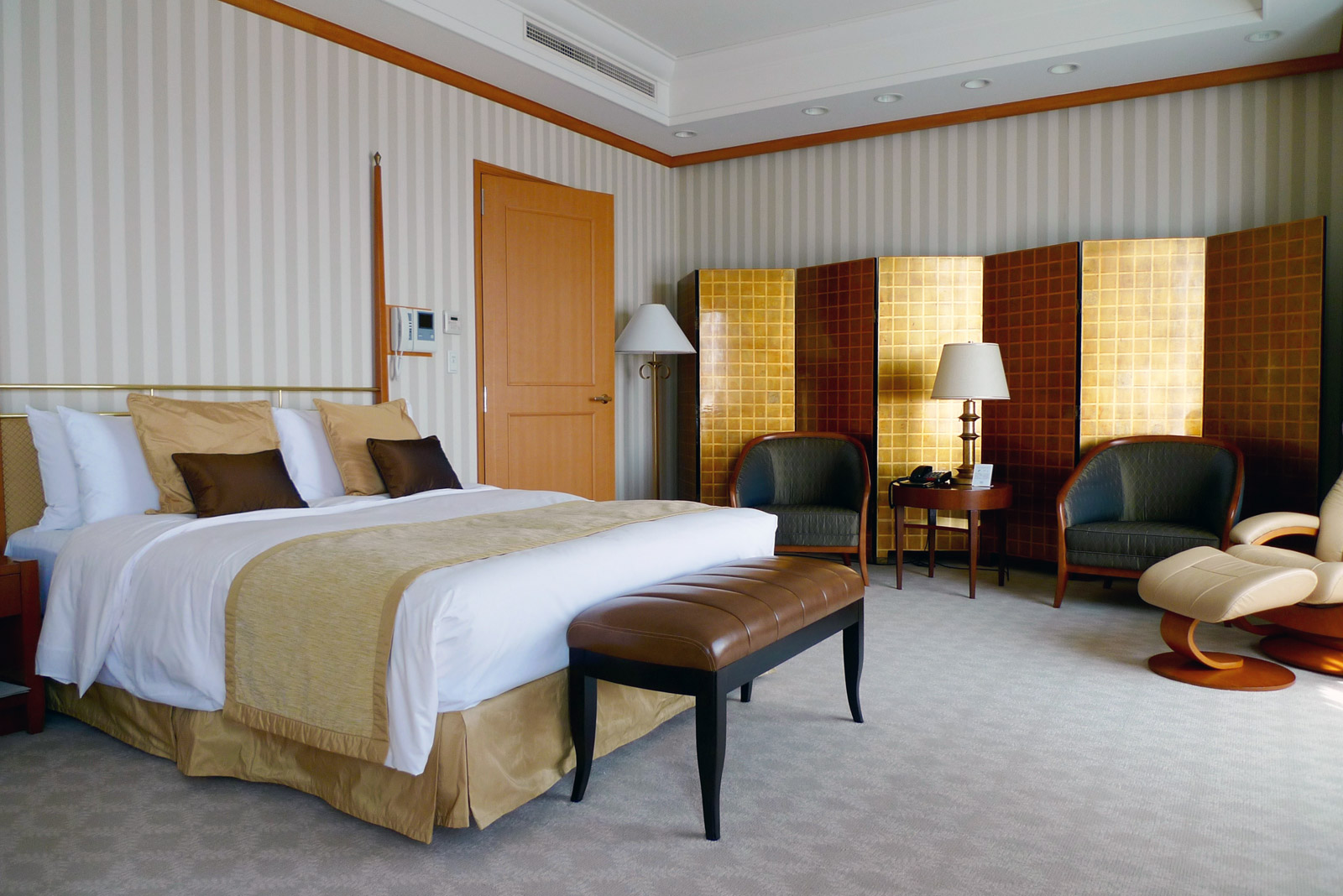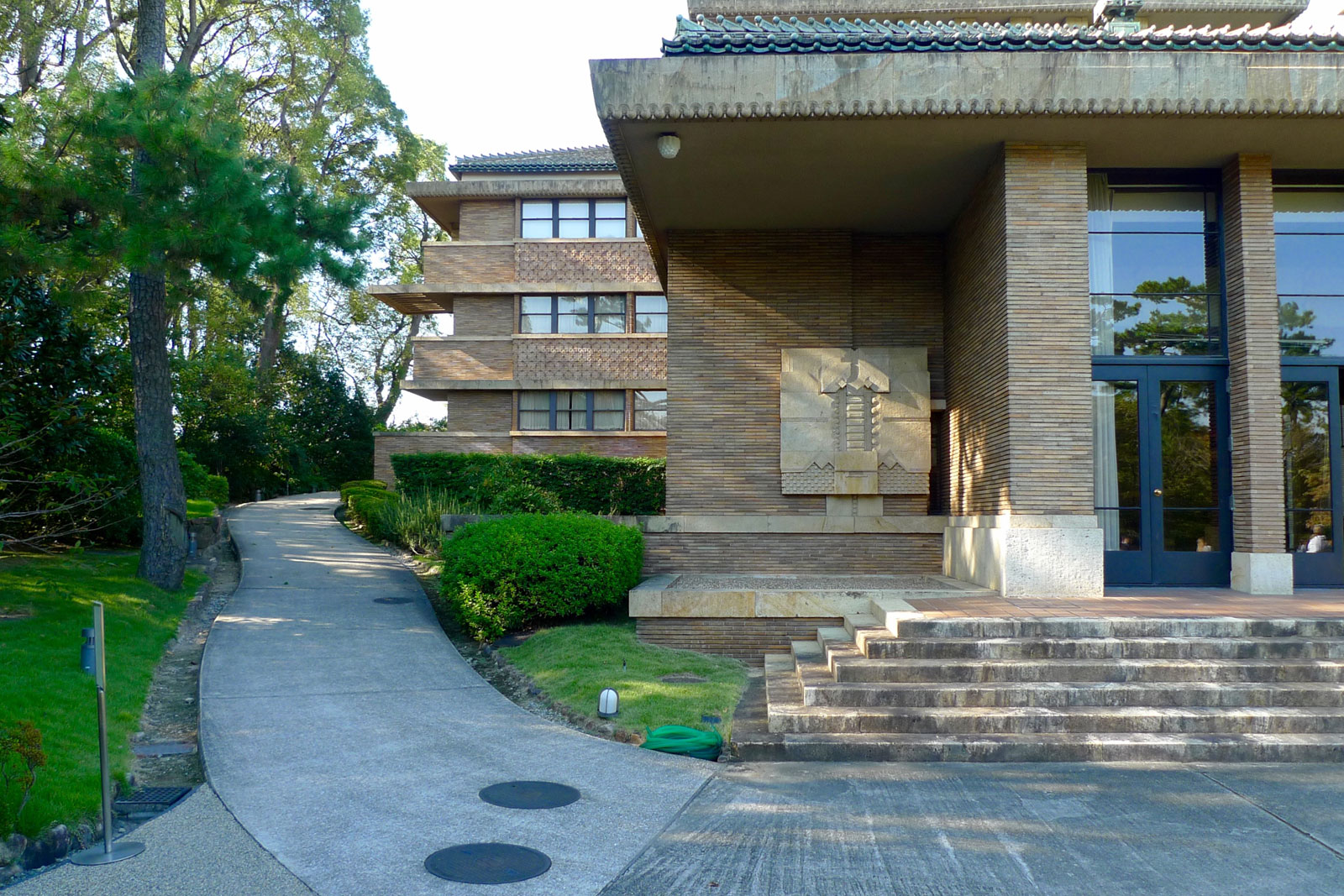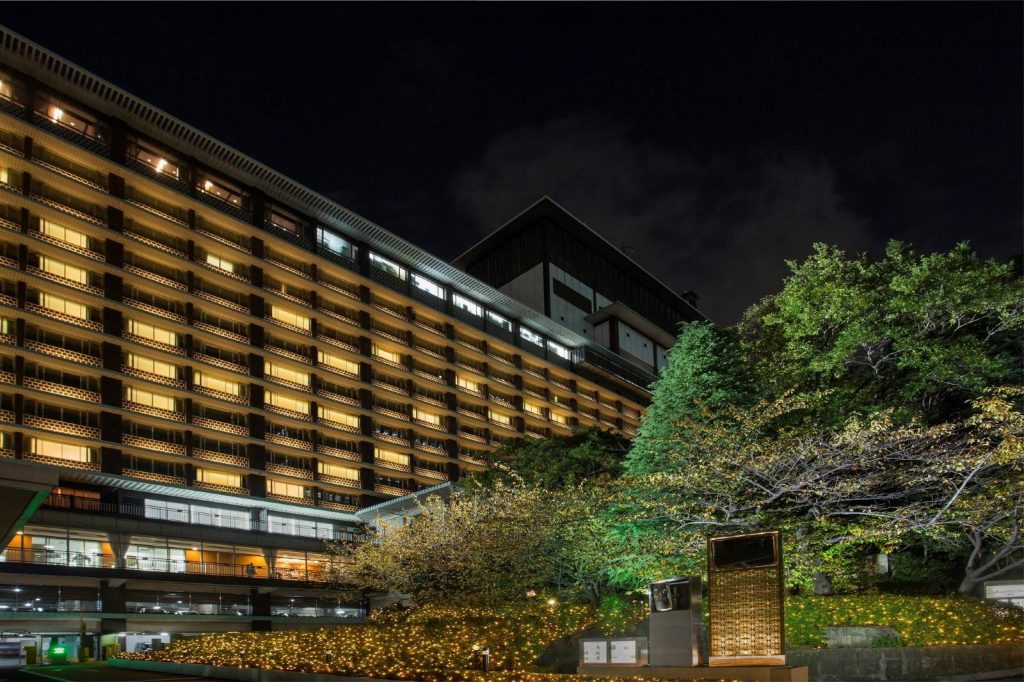Frank Lloyd Wright in Japan
Exploring the famed architect’s work on the occasion of his 150th birthday

As one stands in the lobby of Tokyo’s Imperial Hotel, designed by Frank Lloyd Wright, light streams in through the windows. The hotel was completed in 1923—and demolished entirely in 1968, but where we stand is not a time machine. The experience, with original floor below, and glowing geometric columns around, made out of terra cotta and stone, can be found at Meiji–Mura, an open-air museum dedicated to preserving architecture in Inuyama outside of Nagoya, Japan.
The Imperial Hotel’s long history with the famed American architect has not diminished with the demolition of the structure 50 years ago. Rather, Wright’s innovative and intricate design has set the tone for the style of their current properties. At the Imperial Hotels in both Osaka and Tokyo, Wright’s geometric stained glass glows behind the Old Imperial Bar spirit shelves. Columns and panels throughout the hotel both nod to Wright’s favorite shapes as a tribute to celebrate his legacy.

At the Imperial Hotel in Tokyo, Wright’s influence is on view throughout. A concrete panel in the lobby serves as a place for guests to see his work up close and read about his history at the hotel. The Old Imperial Bar offers the classic cocktails and bar bites that would have been served in the original hotel as well as the environment fully restored from the original hotel design. A new cocktail has been added to the Old Imperial Bar menu called “The Time,” to honor Wright and the hotel’s history. This elegant drink pairs sweet sake and plum liqueur with Woodford Reserve bourbon and pickled plums to serve their East meets West legacy in a glass.
Delving into the history of Wright’s design for the Imperial Hotel, concurrently he was busy trying to make oil heiress Aline Barnsdall happy during the construction of the Hollyhock House in Los Angeles. Both the massive hotel and the luxurious southern California home are examples of Mayan Revival style. Each structure features elements of symmetry and geometry with opulent rooms and smaller details along the corridors and in every nook. In Tokyo, the grand undertaking of the historic hotel also inspired Wright to include massive volcanic stone carvings in the interior and exterior of the building, terra cotta grillwork, with giant lighting fixtures.

Now in 2017, the year of the 150th birthday of the celebrated architect, exhibits, lectures, and celebrations have been planned around the US and in Japan. The Frank Lloyd Wright Foundation offers tours of Taliesin and Taliesin West along with information about the FLW150 celebrations and tours at his other open to the public properties. Currently the Chicago Architecture Biennial offers several opportunities to learn about Wright’s work including tour of the Johnson Wax corporate headquarters in Racine, Wisconsin. In New York, MoMA’s Frank Lloyd Wright at 150: Unpacking the Archive reveals an in depth looks at his work.
Wright’s connection to Japan began early in his life. Wright visited the Japanese pavilion at the 1893 World’s Columbian Exposition where he saw the Ho-o-den, the Hall of the Phoenix. There, following a footpath into the center island Wright was able to experience an example of Japanese art and design first hand. He became an avid collector of Japanese prints throughout his life, often resorting to selling pieces of his collection to get himself out of numerous financial jams.

To trace Wright’s path in Japan, the building of his largest project to date, the Imperial Hotel Tokyo, began in 1917. The massive structure tested Wright and his Japanese and US builders and craftspeople who were working together to pull off the complicated design. With what he referred to as a floating structure with elaborate stone, terra cotta, wood, and materials, the building was completed in 1923. On September 1, 1923 during the hotel’s opening celebration, a massive earthquake struck Tokyo. Numerous buildings in the city fell or were heavily damaged in the temblor, but the Imperial Hotel withstood the catastrophe thanks to its floating structure and large moat pool.
At that time all weddings in Japan took place in shrines and temples. With so many structures reduced to rubble, the Imperial Hotel became the place for weddings, ushering in a new tradition in Japanese culture. Now many hotels build chapels and shrine spaces on property for weddings. The Imperial Hotel Tokyo went on to become a center of hospitality and culture drawing visitors from all over the country and the world until 1968 when the amount of renovation and additions needed to run a contemporary luxury hotel property exceeded what was possible with the existing space. During the time of demolition, elements of the hotel were preserved. Much of the Old Imperial Bar remains intact—from the wall panels to the original look of the glass behind the bar.

The largest preservation from Wright’s Imperial Hotel are housed at the aforementioned Museum Meiji-Mura near Lake Iruka, outside of Nagoya. There, the lobby has been moved and rebuilt amongst the many example of Meiji era architecture to honor the legacy of the hotel and Frank Lloyd Wright’s innovative and provocative design ideas. Complete with the pool of water out front that helped save the structure during the earthquake, visitors can see first hand the symmetrical facade and walk up the steps and through the front doors to experience the feeling of being in the original lobby. A tearoom filled with Wright’s furniture designs serves up warn drinks and sweets. Cases display the original Wright china and servingware.
Just inside the lobby entrance, the “Imperial Hotel Tokyo” setup now has an 150th year exhibit they are calling “Imperial Times” to share visions of the history of the property with artifacts from Wright’s legacy there. Next to the entrance the commemorative display of Wright’s design complete with architectural elements, original china designed by Wright, menus, architectural drawings, furniture, and columns that have been reproduced with terra cotta from the original factory are on view until the end of the year. Soon this will be the site of a more permanent exhibition. It’s a legacy that the staff is proud of and many of the staff is well versed enough to share the history of his work in their country.

The ultimate opportunity to experience how Wright thought about space and form is to go to sleep surrounded by the shapes and textures of his designs. This one of a kind experience comes in the form of a luxurious hotel suite at the Imperial Hotel Tokyo. The living room, formal dining room, and bedroom offer an elegant time machine to the way he thought about living spaces. This dream destination for architecture fans is filled with warm woods, geometric patterned carpets, and sculptural lighting fixtures. It’s a beauty.
Standing inside the dining room one imagines how living in Wright’s own home maybe have felt. Imagine walking down the streets of Ginza with intricately shaped gleaming glass buildings, the most futuristic vistas in Tokyo, then entering the hotel and stepping into the warmth of the Frank Lloyd Wright suite. This dreamy vision connects present to past and design to emotion. And in Wright’s case the Midwest to the Far East.

The Shinkansen train from Tokyo to Osaka rolls by 300 miles in two-and-a-half hours. Wright’s influence can also be found throughout the Imperial Hotel Osaka where carved wood and geometric brick work as well as in the stained glass and luxurious environment of their Old Imperial Bar. A circle spotlight glows for each guest sitting at the bar where expert bartenders stir and shake cocktails and place their creations in the light.

Nearby in Nishinomiya the students at Mukogawa Women’s University study architecture at the former Koshien Hall designed by one of Wright’s disciples Arata Endo. There they learn about the work of Wright and other significant architects. With first year projects including detailed drawings of the building and learning how to make the roof tiles that are put to use but restoration and upkeep. Students have also been given photographs of Wright furniture and been asked to recreate to scale, along with other hands on experiences around the city. This educational commitment to learning the history of architecture to develop new design ideas and foster innovation may be one of the most fitting tributes to Wright’s work.

Back in Tokyo, Wright built the Myonichikan building for a girls’ school in 1921. It has been restored and remains open as the alumni building and is open for tours, giving one more place for people to experience a Wright building in Japan. Though Wright adamantly professed to have no specific influences, his love for Japanese art and design is undeniable. In turn, the country understood and appreciated his buildings and continue to find life in the Imperial Hotel world and beyond. In Japan the designs of an eccentric Midwestern architect were both innovative for the time and set into the Japanese landscapes and cityscapes they inhabited.
Second, seventh, eighth and last images by Julie Wolfson, all others courtesy of the Imperial Hotel












